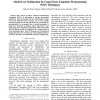Free Online Productivity Tools
i2Speak
i2Symbol
i2OCR
iTex2Img
iWeb2Print
iWeb2Shot
i2Type
iPdf2Split
iPdf2Merge
i2Bopomofo
i2Arabic
i2Style
i2Image
i2PDF
iLatex2Rtf
Sci2ools
DIMEA
2007
2007
Player adaptive entertainment computing
The concept of Player Adaptive Entertainment Computing (PAEC) is introduced to provide personalized experiences when interacting with the entertainment media. Two of the important areas in PAEC are to create specific targeted strategies to cater for individual user, and to perform personalization. To accomplish this, a suitable mechanism to model user experience is required. This is explored in a case study using Neuro Linguistic Programming (NLP) that models the NLP spatial anchors of experiences of a sample group of users during game play. These NLP anchors are reconstructed during game play of a second group of users allowing them to experience the same level satisfaction as the first sample group.
| Added | 14 Aug 2010 |
| Updated | 14 Aug 2010 |
| Type | Conference |
| Year | 2007 |
| Where | DIMEA |
| Authors | Kevin Kok Wai Wong |
Comments (0)

